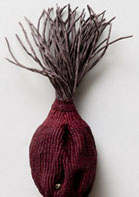


| 
|
But Are They Baskets? "Charlotte Thorp has been making contemporary baskets as art objects for the past 12 years. Her efforts have focussed on ways to create excitement and tension on a small scale. She grapples with the inherent instability of contrasting qualities--tight/loose, smooth/rough, symmetrical/asymmetrical, thick/thin, flat/deep, colorful/muted, open/closed, glossy/matte, unambiguous/enigmatic. She employs the ancient basketry technique of twining. The materials are, for the most part, paper, waxed linen thread and leather cord--honest, age-old and unassuming, yet unconventional in the way she manipulates them. Many of her single pieces feature colorful spokes, spun by hand of kozo paper, which burst from a tightly woven surface in unpredictable ways. Virtually every basket has an opening in the woven surface. In exploring aspects of containment and secrecy, she makes pieces in which the whole is not revealed at once: her vessels often turn in upon themselves and enclose mysterious inner spaces. She has recently been making series of baskets with openings facing the viewer, some of them set within boxes (wall-hung at eye level) open at the front. The viewer is urged to move forward and peer inside. Changing vantage points alternately conceal and reveal, raising questions about exposure. Some of these works allude to uncertainty and accessibility; others are intense color studies with the baskets emerging from images of nature.
But are they, in fact, baskets? They cannot hold anything, nor do they suggest containers in the abstract. They do not always sit on a horizontal surface, and the inside surface is often not visible (although the inside in terms of volume is important for what is not revealed). It has been suggested, in view of the technique, that they be called...works in the basket tradition. I think they are sculptural objects that reference baskets, and as such are an integral and welcome component of the current renaissance in fiber art."
|